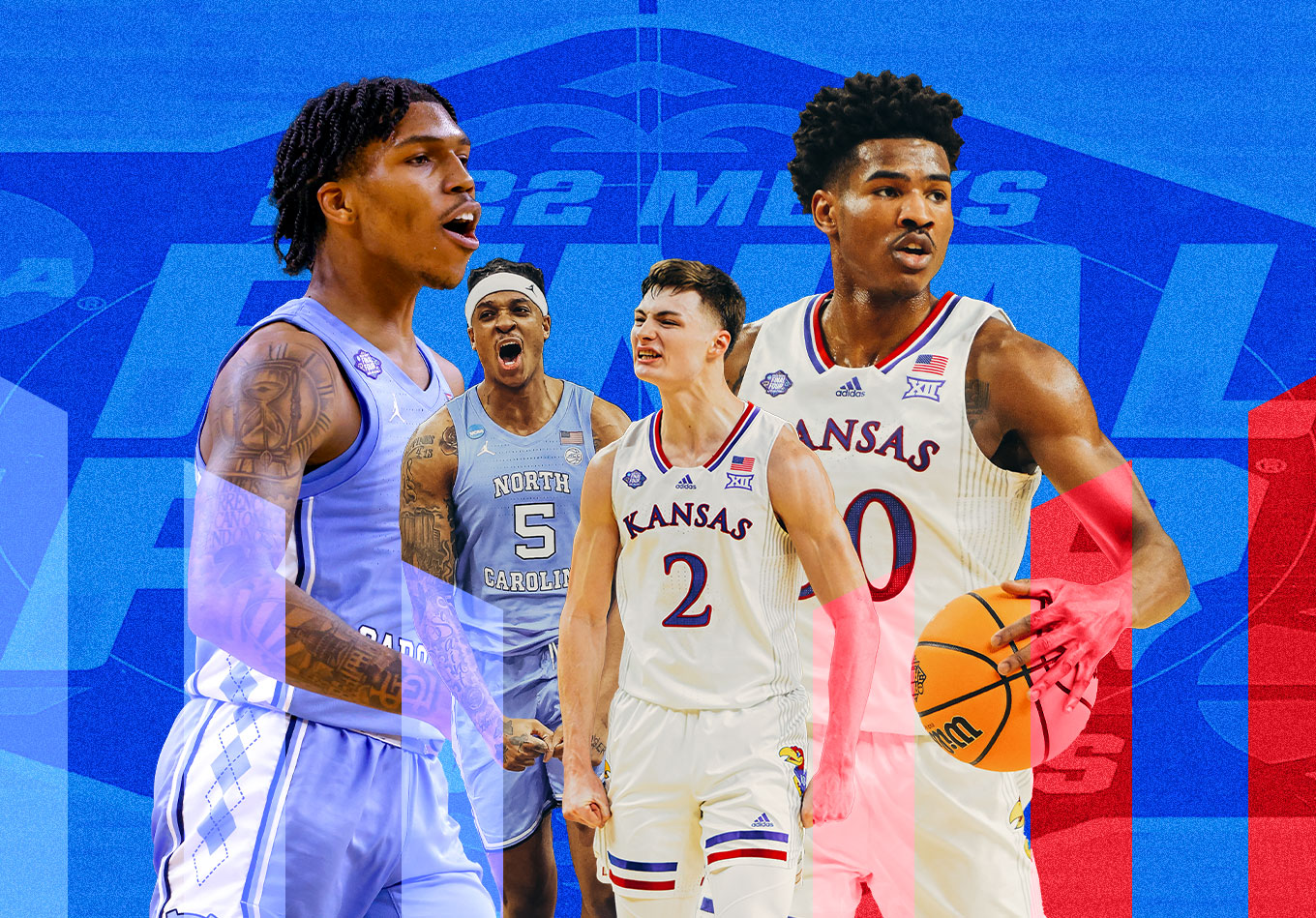It’s been a thrilling few weeks of March Madness and it all comes down to this.
It’s the North Carolina Tar Heels and Kansas Jayhawks in a battle of blue bloods for the prize of NCAA Tournament immortality.
While we’ve certainly grown to know these teams well as they’ve made their respective runs to the title game, let’s dive in a bit deeper by leveraging AutoStats player tracking and event-level data and our TRACR model to preview key matchups and statistical signals ahead of the championship game.
AutoStats uses body recognition technology to identify player position and movement across the entirety of the court. The tool collects comprehensive tracking data from any game through any television broadcast, providing us with new information on NBA Draft prospects.
TRACR (Team Rating Adjusted for Conference and Roster) is our net efficiency metric that evaluates how well teams perform based on whom they play. The model is trained on over 15 years of college basketball data, rewarding big wins over good teams and punishing losses to bad ones or even wins that were closer than expected.
TRACR’s win probability (listed further below) is based on 1,000 simulations.
Rebounding
We’ll start on the boards, where Jalen Wilson and Armando Bacot were identified as two of the five top returning offensive rebounders in America in our preseason analysis of the top returning rebounding prospects in the nation per AutoStats. Leaky Black was also tabbed as the second most versatile rebounder in college basketball.
We’ve seen this play out, especially with Bacot, who has followed suit by ripping down eight offensive rebounds in each of the Sweet 16, Elite Eight and Final Four contests.
Over the course of the season, Bacot ranks second in the nation in total rebounds (first in defensive, second in offensive), trailing only Kentucky’s Oscar Tshiebwe, who was also highlighted in our preseason analysis. Bacot can surpass Tshiebwe as the nation’s rebound king if he exceeds 20 rebounds in the championship tilt.
That certainly isn’t out of the question given Bacot’s extraordinary rebounding prowess in the tournament, wherein he just became the first player with back-to-back 20-rebound March Madness performances since Tim Duncan in 1997.
While Bacot got dinged up late in a Final Four victory over Duke, he’s indicated his readiness to fight through the pain Monday night stating, “My right foot would have to be cut off for me not to play.”
While Kansas’ David McCormack ranks fourth in the country with a 17.3 offensive rebounding percentage, Bacot should be able to handle him. Bacot’s 2021-22 AutoStats adjusted rebound percentage of 81.8% dwarfs McCormack’s 68.2%.
While Jalen Wilson continues to produce as a rebounder, his contested rebounding percentage has dipped from 57.7% last season to 39.4% this season. With Leaky black flying around, crashing with reckless abandon, and Bacot applying consistent pressure, Wilson could be a bit overmatched on the glass as well.
Edge: North Carolina
Ball Movement
The Tar Heels and the Jayhawks have varying offensive philosophies and styles of execution.
If we classify their passes, we can glean a bit of insight on each team’s tendencies.
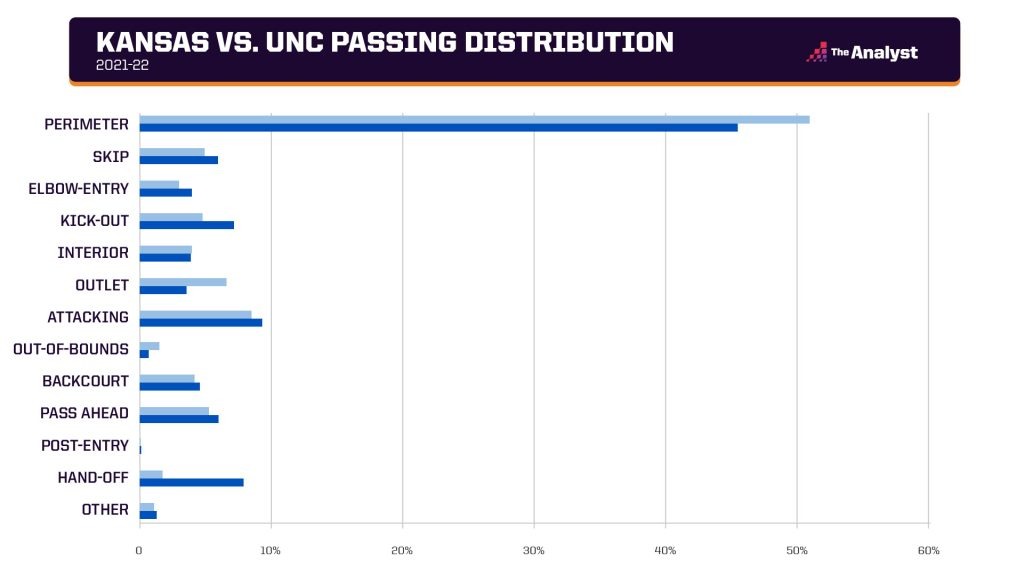
While most teams’ distributions will follow a generally similar pattern, there are a few things that stick out here.
UNC tends to zip the ball side-to-side around the perimeter a bit more than the Jayhawks, who mix in a higher volume of skip passes, kick-outs, handoffs and attacking passes in the half court.
Despite this, Kansas notches a higher percentage of assists that were preceded by a secondary assist at 47.2% as compared to UNC’s 43.4%.
This likely stems from UNC ultimately relying on the isolation prowess of Caleb Love and RJ Davis when nothing breaks free following initial side-to-side actions and subsequently, Bacot’s putback prowess following misses.
Both teams fall just outside the first quartile of NCAA team assist percentages, essentially with dead even assist rates just above 54.0%.
Both teams have three creators averaging 2.5 or more assists per game.
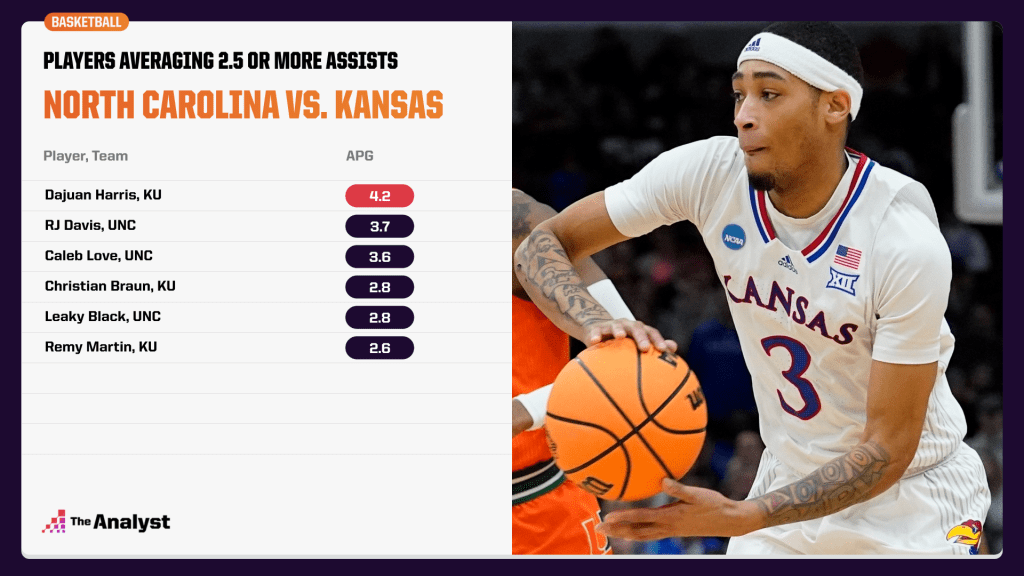
This one is a close call, but Kansas is a bit more purposeful with its passing attack and has more ways to kill you.
Edge: Kansas
Shot Quality
This is what will likely swing the game.
The game’s two biggest stars, Love and Ochai Agbaji, are both coming off of outstanding 20+ point performances in the Final Four. But whose performance is more sustainable? And which teams’ shot-creators are more likely to create quality looks when it matters most?
Agbaji and Braun, both of whom look to have NBA futures, take a collective 24.5 shots per game for Kansas, while Love and Davis take a collective 24.0 shots per game for North Carolina.
Let’s peel back the curtain as to the quality of these looks by examining average shooter influence, which is a measure of defensive pressure on a scale of 0-100 (zero being your defender is laying down on the other end of the court, 100 you’re being bear hugged), and expected effective field goal percentage.
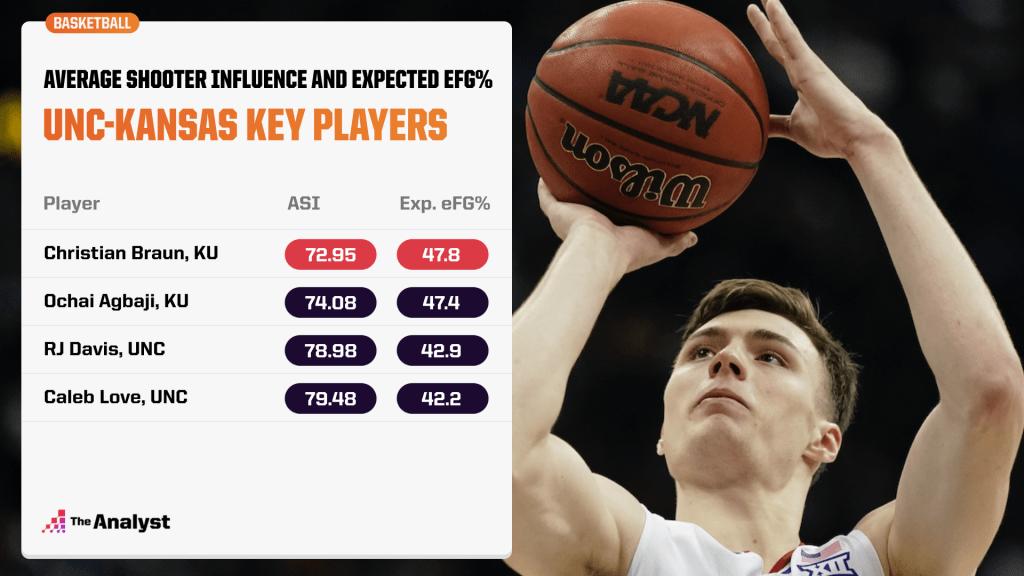
Kansas has a clear advantage in that the shot quality for Braun and Agbaji is much better than that of Davis and Love. Braun and Agbaji stand 6-foot-5 and 6-foot-6, respectively, as compared to Davis and Love’s 6-foot and 6-foot-4 and are less dependent on self-created, contested pull-ups off the dribble.
While Leaky Black’s 77.48 average defensive shot influence as a fluid 6-foot-8 perimeter defensive menace should help curb the quality of their looks to some extent, these Kansas stars are a safer bet to hold up on the big stage.
Edge: Kansas
Verdict
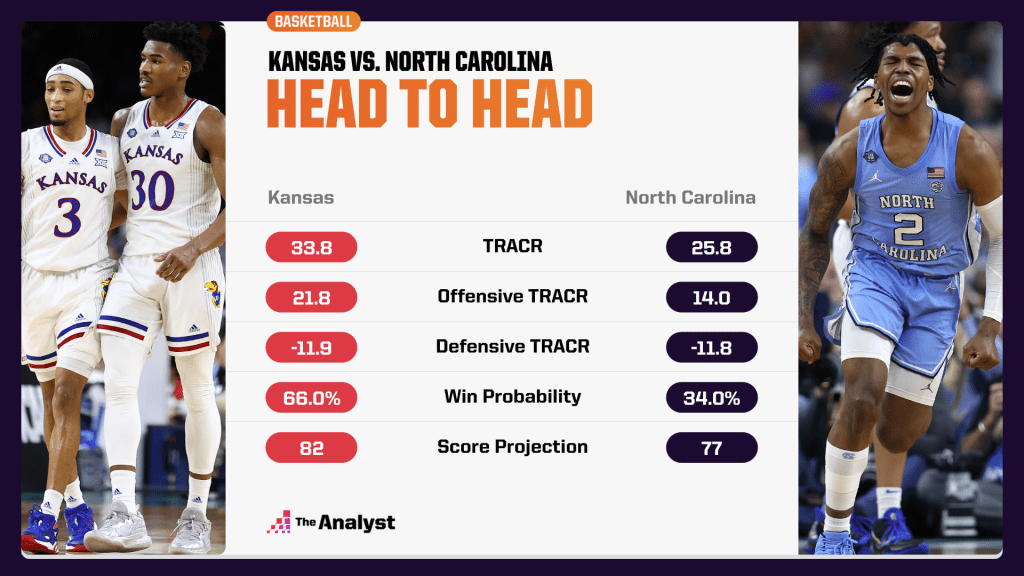
As Stats Perform data scientist and TRACR analyst Evan Boyd told us last week, TRACR’s modeling includes a recency bias, which is why it had Kansas as the favorite to win it all heading into the Final Four.
It also indicates that the Jayhawks’ style of play should give it an advantage over the Tar Heels.
Enjoy this? Subscribe to our mailing list to receive exclusive weekly content.
Graphic design by Briggs Clinard.
